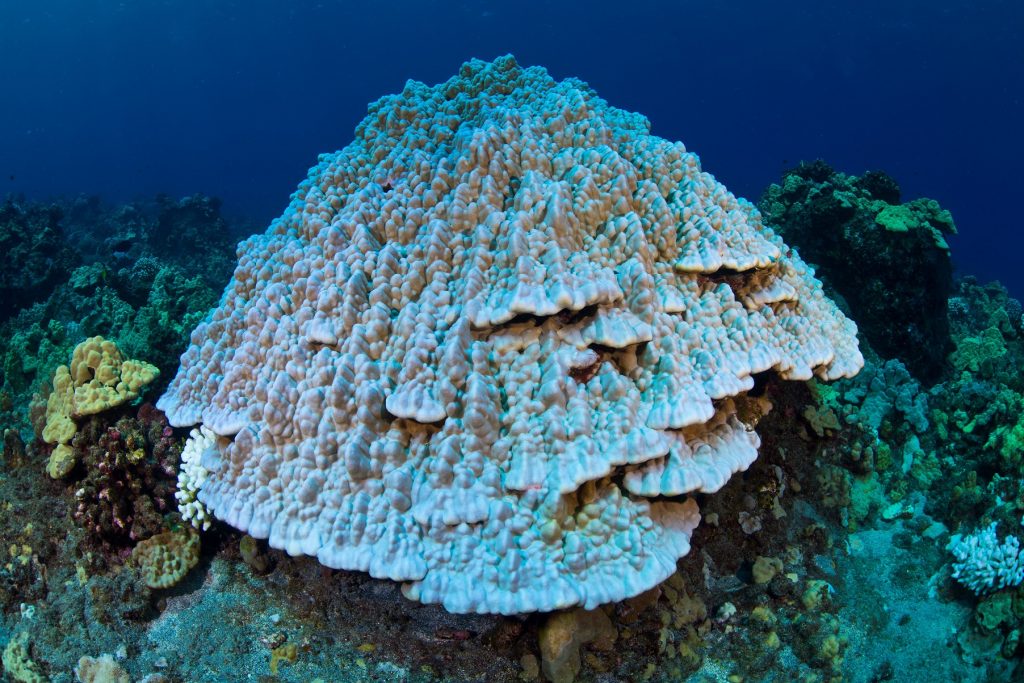08/23/19-DLNR & NOAA ASK FOR HELP DEALING WITH UPCOMING CORAL BLEACHING EVENT
Posted on Aug 23, 2019 in Aquatic Resources, Main, sliderNews Release
| DAVID Y. IGE GOVERNOR |
SUZANNE D. CASE
CHAIRPERSON |
For Immediate News Release: August 23, 2019
DLNR & NOAA ASK FOR HELP DEALING WITH UPCOMING CORAL BLEACHING EVENT
Possible Severe & Widespread Bleaching Across the Islands
To view this video please click on photo or view at this link: https://vimeo.com/355618916
(Honolulu) – Data from the National Oceanic and Atmospheric Administration’s (NOAA) Coral Reef Watch program, indicates Hawai‘i’s coral reefs are entering a major bleaching event within the next two months, if not sooner.
Rising sea temperatures are likely to cause corals in Hawaiian waters to bleach and even die. According to NOAA scientist Jamison Gove, “Ocean temperatures are extremely warm right now across Hawaii. They’re about 3°F warmer than what we typically experience in mid-August. If the ocean continues to warm even further as predicted, we are likely to witness a repeat of unprecedented bleaching events in 2014 and 2015.”
“We’re already observing bleaching of corals in West Hawai‘i, along with some paling of other species at some of our long-term monitoring sites,” said Nikki Sanderlin, acting Aquatic Biologist for the DLNR Division of Aquatic Resources (DAR) West Hawai‘i district office.
Coral bleaching is a change from normal coloration of browns, yellows and greens to a nearly white color. This change occurs when corals are stressed by environmental changes, especially temperature increases. Although corals can recover from moderate levels of heat, if it is prolonged, they will die. But scientists say that reducing secondary stress on corals during these bleaching events can improve the chances of coral survival.
DAR Administrator Brian Neilson explained, “We know this bleaching event is coming and it’s probably going to be worse than the ones we experienced four and five years ago. West Hawai‘i experienced a 50% mortality rate and Maui experience 20-30% mortality rates on fixed DAR monitoring sites. We’re asking for everyone’s help in trying to be proactive and to minimize any additional stress we put on our corals.”
DLNR and NOAA are asking you to help:
- Avoid touching corals or coral reefs while diving, snorkeling or swimming
- Do not stand or rest on corals
- Use reef-safe sunscreens
- Boaters should use mooring buoys or anchor only in sand areas
- Keep anchor chains off the reef
- Fishermen should reduce or stop their take of herbivores, such as parrotfish (uhu), surgeonfish & sea urchins. Herbivores clear reefs of algae, which over-grow and kill corals during bleaching events.
- Take extra precaution to prevent other potential contaminants from getting to the ocean:
- Dirt from poorly managed commercial and private earth work
- Chemical pollution from fertilizers, soaps, detergents used in outdoor watering, car washing, etc.
- Other contaminants like oil from poor containment practices
Neilson added, “These are actually things we should be doing all the time, but it’s especially important now. We’d also like swimmers, snorkelers, and divers to report when and where they see both bleaching and healthy corals. Those healthy corals may provide valuable information about how some corals are better able to survive these types of events.”
In October, DLNR will introduce an initiative aimed at tour operators to inform their guests about good reef practices. Numerous operators, like FairWind Big Island Ocean Guides on Hawai‘i Island are already educating people on their boats, asking them not to stand on, sit on, or touch the reef and to use reef-safe sunscreen products. On a recent tour to Kalakekua Bay, Captain Dante Leuenberger told snorkelers, “The bottom is alive. Coral is a very delicate animal. For your own safety and the health of the reef we ask you to stay off the bottom. Don’t touch anything, don’t stand up anywhere.”
DLNR and NOAA are using new technology to better understand the real-time extent of predicted bleaching events. Arizona State University, which created and is maintaining the Hawai‘i coral website noted below, is providing weekly satellite imagery which helps identify bleaching areas. This information is publicly available on the website.
# # #
To report bleaching:
Media Contact:
Dan Dennison
Senior Communications Manager
Hawaii Dept. of Land and Natural Resources
[email protected]
(808) 587-0396
